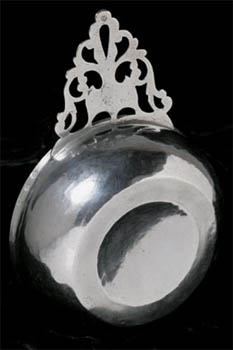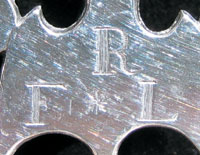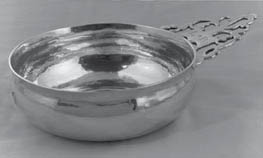 |
| Home | Articles | All in the Family: Joseph Richardson's Earliest Silver |
 |
by Jay Robert Stiefel
A previously unrecorded silver porringer(Fig. 1) apparently a presentation piece for his family - has emerged as the earliest datable work of Philadelphia's renowned silversmith Joseph Richardson (1711-1784).1
Three generations of Richardson silversmiths dominated their craft in Philadelphia for a hundred years. Joseph was the second surviving son, and an apprentice, of Francis Richardson (1681– 1729), the dynasty’s founder.
 |
|
|
|
| Fig. 1: Silver porringer by Joseph Richardson (1711–1784). Diameter 53/16 in., length of handle 25/8 in. Private collection; photography by Luigi Pelletieri. |
|
The fortuitous survival of some of Joseph’s account and letter books formed the basis of Martha Gandy Fales’s Joseph Richardson and Family, Philadelphia Silversmiths, the “sterling standard” of artisanal biography.2 As colonial American silver lacks England’s dated assay marks, Fales developed date ranges for each of Joseph’s marks by extrapolating from the objects she could identify in his transactions. While she recognized his first mark as in use circa 1730, Fales had difficulty ascribing dates before 1733 to any of his pieces because his extant ledgers contained no prior entries.
The porringer in figure 1 is uncited by Fales. Given its significance, she must not have known of it. It precedes in date any of Joseph’s recorded silver and is, as will be demonstrated, his earliest surviving work that can be dated with any fair degree of certainty.
While silver porringers with shallow bowls and single broad handles appear in England as early as 1623,3 they were never to become as widespread there as in colonial America. By the eight-eenth century porringers vied with canns and tankards as the most common drinking vessel listed in Philadelphia household inventories. They were described as being in pewter and earthenware, as well as in silver. Joseph Richardson supplied at least 129 silver porringers between 1733 and 1748, often in pairs or sets.4
Although Joseph imported some silver wares from England, no porringers were among them. That is not to say that Joseph made all of
the porringers sold by him. As early as 1734, some came from the hands of his brother Francis Richardson Jr., known as Frank (1706–1782), and others from those working in Joseph’s shop.5
Nonetheless, all of the porringers from Joseph’s shop bear certain similarities. They weigh between approximately seven and nine ounces (and cost from ten to twelve shillings, depending upon weight). Their convex sides curve up from domed bottoms to form everted, undecorated rims. Joseph’s handles are of like form, not just to one another, but to those found on the work of several other mid-eighteenth-century Philadelphia silversmiths: All have a pierced keyhole just below the tip of the handle and a shield-shaped area near the base of the handle to accommodate engraving of initials.6 Joseph’s earliest porringers also have two pierced semicircles at the base of their handles, which are lacking in his porringers from the late 1740s.7
The porringer in figure 1 has these two semicircles and bears Joseph’s first mark: the initials “IR” in an oval, which was in use, according to Fales, “c.1730–1740.”8 The mark is struck four times: once under the tip of the handle and thrice more under the outside of the bowl rim to the left of the handle (Figs. 1a-1b). Under the dome of its bowl is a scratch weight of 7 ounces, 12 pennyweight.
|
 |
|
|
|
Fig. 1a (above): Reverse of porringer by Joseph Richardson showing mark “IR” in an oval, struck once under tip of handle and three times on outside of bowl rim to left of handle. Fig. 1B (top right): Detail of mark. Private collection; photography by Luigi Pelletieri.
|
|
The coincidence of the particular initials engraved on the top of its handle “R / F*L” (Fig. 1c) is so rare as to severely limit the possible candidates for original ownership. In keeping with the stylistic convention of the period, the initial of a couple’s surname would be on top, that of the husband’s given name to the bottom left, and that of the wife’s to the bottom right. In the first half of the eighteenth century, given names beginning with “F” for men and “L” for women in Philadelphia were not as varied or common as others. Couples with both those initials would have been even less frequent. Adding a surname beginning with “R” narrows the field still further.
In all of Joseph’s surviving accounts, I could find no individual with the initials “LR,” and only one with the initials “FR,” namely Joseph’s elder brother Frank.9 The three initials on the porringer cannot pertain to Frank and his wife, as “L” was not her first initial. Also, as he and Mary Fitzwater were not married until November 26, 1742, any porringer Joseph made for them would likely have borne one of the marks he used after 1740, not his earliest, as here.10 Although it is conceivable that it could have been ordered prior to the 1733 starting date of Joseph’s extant records by or for some now unknown couple with the unusual “FLR” combination of initials, there is one couple in this period whose initials are a perfect match, and for whom ownership of this porringer would have been especially appropriate, namely his father, Francis, and his stepmother, Letitia Richardson.
|
After twelve years of raising his sons as a widower, Francis had married Letitia Swift on April 30, 1726.11 When Francis died on August 17, 1729, Letitia remained a widow only two years, marrying Jeremiah Elfreth on July 8, 1731.12 Thus, Francis and Letitia’s marital lives—and initials—were conjoined for only three years, 1726–1729; and she remained “LR” for only twofurther years, until her remarriage in 1731.
|
|
|
 |
|
|
|
Fig. 1C: Detail of engraved initials on top of handle facing bowl and above two pierced semicircles: “R / F*L.” Private collection; photography by author. |
At his father’s death, Joseph was a month shy of his eighteenth birthday. Under normal circumstances he would have had at least three more years—until age 21—to complete the customary seven-year term of apprenticeship. But he must already have demonstrated his ability, as his father bypassed Frank, a trained silversmith, aged 23, and chose Joseph to carry on his silver business—for the benefit of Letitia—until he reached his majority:
unto my son Joseph…all my working tools provided he continue and live w[i]th his Mother in Law [that is his stepmother] and Carry on my Trade for her untill he Shall attain to his full age of Twenty One Years.13
For a man who was to entrust both his silver business and the livelihood of his widow to Joseph’s care, it would not have been difficult for Francis to accord earlier acknowledgment of his son’s abilities by allowing him, while they were still at work together, to affix his own mark to a piece of silver. Francis himself had been working prior to age 21. No English hallmarking regulations constrained them in America, only whatever custom they chose to follow. Here, silversmiths marked their wares as much for pride as anything else. While we know little of marking conventions in Philadelphia, a porringer made and marked by Joseph as a presentation piece for his father and new mother—for exclusive use within their family—would probably have raised few artisanal eyebrows.
That the porringer in figures 1–1c was made by Joseph as a present to Francis and Letitia between the date of their marriage in 1726 and the death of Francis in 1729 becomes even more convincing when we compare it to one which Fales attributed as Francis Richardson’s own possible gift to his bride (Fig. 2). The latter bears a single mark under its handle: the initials “FR” within a shield under a crown (Fig. 2a). On the top of its handle are engraved, in block letters, the initials “L*R” (Fig. 2b).14 Even without knowledge of Joseph’s “R / F*L” porringer, Fales had suggested the Francis/Letitia connection:
The closest connection with actual documentation is achieved by a silver keyhole porringer…engraved with the initials L*R and the weight 7 oz. 12 dwt. At his death, Francis left his widow, Letitia Richardson, two silver porringers which weighed approximately six or seven ounces each. Since his widow’s initials were L.R., it is possible that this porringer is one of the two bequeathed.15
|
There are so many similarities between these two porringers, as well as variances from Joseph’s later porringers, that there can be little doubt that, not only was Fales right about the “L*R” porringer, but that both were produced, en suite, as presentation pieces by father and son in honor of the marriage to Letitia. Both bear the scratch weight of 7 ounces, 12 pennyweight and are otherwise virtually identical in dimensions.16 Both are of like form, and both have the two semicircles found at the base of the handles on Joseph’s earliest porringers (Figs. 1 and 2b).17 The engraved initials on the two handles face their bowls. By contrast, the initials on all other Joseph Richardson porringers of which I am aware, and as Fales also noted, face away from their bowls.18
 |
|
|
|
Fig. 2: Silver porringer by Francis Richardson (1681–1729). Diameter 51/8”, length of handle 25/8” (measurements per Martha Gandy Fales, Joseph Richardson and Family Philadelphia Silversmiths, fig. 4 caption). Whereabouts unknown. Photograph courtesy of DAPC, Winterthur Museum.
|
|
Indeed, the form and execution of the block initials on both handles are so close as to suggest the hand of the same engraver. Both have the same pronounced serifs. Undoubtedly for spatial considerations, the letters differ only in the direction of their shading. The “L” and “R” initials on Francis’s porringer (Fig. 2b) are shaded horizontally to broaden their appearance and better fill the space. To avoid a cramped appearance, the greater number of initials on Joseph’s handle (Fig. 1c) are shaded vertically. (The “R” as the lone initial at the apex is still shaded horizontally on its right side, giving it more sweep and lending better balance to the triangular arrangement.) Although Joseph had ordered a book of cyphers when he was only fourteen, the engraving on both porringers is so distinct from his usual block shading, which slants downward and to the left, that he would appear not to have engraved either one.19
|
Another engraved element identical to both porringers is their central decorative motif, resembling a snowflake (Figs. 1c and 2b). It is distinguishable from Joseph’s later work, where he “usually placed only a single dot in the center of the cluster, rather than a decorative motif.”20 Here it stands as one more indication that the two porringers arecontemporaneous to Joseph’s apprenticeship with Francis. Perhaps Francis, or someone working for him, was the engraver.
|
 |
|
|
|
Fig. 2a (above): Detail of mark “FR” in a shield under a crown, struck under center of handle. Whereabouts unknown. Photograph courtesy of DAPC, Winterthur Museum. Fig. 2b (above right): Detail of engraved initials on top of handle facing bowl and above two pierced semi-circles: “L*R.” Whereabouts unknown. Photograph courtesy of DAPC, Winterthur Museum.
|
|
Thus, the many correlations between Joseph Richardson’s previously unrecorded “R / F*L” porringer (Figs. 1–1c) and his father’s “L*R” porringer (Figs. 2–2b) bear witness that both were made sometime between 1726 and 1729 to honor Francis’s marriage to Letitia. By its like design and execution, and the inclusion of his father’s “F” initial, Joseph may also have meant his porringer as a filial tribute. It was proof of his ability to carry on his father’s trade, as was his destiny, and emulate Francis’s work down to every last detail and pennyweight. If completed after Francis’s death in 1729 as a commemorative piece, Joseph could have presented it no later than Letitia’s remarriage to Elfreth, in 1731, as her initials would then have changed. In either circumstance, the porringer survives as the earliest datable silver of Joseph Richardson.
|
|
Jay Robert Stiefel, a decorative arts historian, lecturer, and consultant, is an authority on Philadelphia artisans. In March, he spoke on “Russia Leather” as part of a workshop he jointly conducted on original leather upholstery at Winterthur Museum’s Furniture Forum. On June 22, he will lecture
on “New Discoveries in the Decorative Arts of Colonial Philadelphia” at The American Museum in Britain, at Claverton Manor, outside Bath, www.americanmuseum.org.
- The porringer first came to my attention in January 2002. It was then offered by silver dealer Jonathan Trace at the Winter Antiques Show in New York. Trace authenticated the porringer as being by Joseph Richardson and bearing his first mark, but could offer no provenance other than that a picker had found it in a New England household. My thanks to Jonathan and the following individuals for their courtesies in connection with this article: Bert Denker, Donald L. Fennimore, Kathleen A. Foster, Beatrice Garvan, Jack L. Lindsey, Richard A. Mones, M.D., and Jeanne Solensky.
- Martha Gandy Fales, Joseph Richardson and Family Philadelphia Silversmiths (Middletown, CT: Weslyan University Press for The Historical Society of Pennsylvania, 1974). The incomplete accounting records of Joseph Richardson’s shop, 1733–1748, together with other materials, are at HSP. Fales’s workfile is in the Downs Collection, Winterthur Library: Richardson Family Research Papers, 1954–c. 1991, col. 573.
- A single-handled example with that assay date is cited in Michael Clayton, The Collector’s Dictionary of Silver and Gold of Great Britain and North America (New York and Cleveland: The World Publishing Company, 1971), 28. In England, “porringer” usually applies to similarly shaped vessels with two handles that often have covers. The English refer to those with single handles as “bleeding bowls.” Ibid.
- 4 Fales, 119, 295, n. 34.
- During 1734–37, Frank is recorded in Joseph’s accounts as a subcontractor, paid for fashioning many forms, among them porringers, and returning any excess from the silver supplied by Joseph. Fales, 23–24. From 1735, journeyman John S. Hutton and, from 1745, apprentice David Harper are also noted as making
porringers for Joseph. Ibid. 62–65, 295, n. 34.
- See similar handle on porringer by Anthony Bright (fl. 1735–1751) in Jack
L. Lindsey, Worldly Goods (Philadelphia: Philadelphia Museum of Art, 1999,
2nd printing), 196, fig. 260.
- Fales, 119. Trace advises that such early handles are today referred to as “double-slotted.”
- Fales described the mark as “[c]haracterized by slightness of serifs, downward sweep of right foot of R, wedge-shaped left foot giving the appearance of a break in the die.” Fales, 73, fig. 32a.
- As Joseph sometimes noted which initials were to be engraved, I also checked those entries—without result.
- Fales, 73.
- Arch Street Quaker Meeting Minutes E-3, 134–135. Francis’s first wife and the mother of Frank and Joseph, Elizabeth Growden, had died on May 19, 1714.
- Ibid. E–26, 118.
- Philadelphia Wills, 1729–127. The will was dated May 1, 1729, and proved August 29, 1729. Frank was given 400 acres and 500 pounds as his share of the estate. Ibid. In passing his tools and business to Joseph rather than Frank, Francis may have meant no affront to Frank, who may already have been independently established and had his own tools. Although Frank worked in silver, both under his own mark and for Joseph, he is better known today for his activities as a merchant and clockmaker.
- Although the present whereabouts of Francis’s “L*R” porringer are unknown, Fales’s detailed description and a set of photographs, reproduced here, survive. Decorative Arts Photographic Collection, Winterthur Library, #BP69.482A–C. See also Philadelphia Museum of Art, image #14–1956–3, used for its 1956 show of Philadelphia silver (item #329) and by Fales, as fig. 4, when the “L*R” porringer was owned by the late Mr. and Mrs. Henry W. Breyer Jr.
- Fales, 11 (n. & fig. nos. omitted).
- The inventory of Francis Richardson lists “Two Silver porringers,” together weighing 13 ounces, 14 pennyweight. Fales, figs. 13–14. Fales presumes that these are the two bequeathed to Letitia. However, the scratch weights of the two porringers under discussion aggregate 15 ounces, 4 pennyweight, or 1H ounces greater than those inventoried. Normal wear and tear over so short a period would not account for such a variance, absent a mistake of weighing or computation, or a misreading of notes by the appraisers. There may once have been a third, lighter porringer, by Francis or perhaps—to round out the family effort—by Frank, which together with the existing “L*R” one, would account for the weight of the two in the inventory. Were Joseph’s not presented until after Francis’ death, it would not have been inventoried in his estate.
- Francis was among the first Philadelphia silversmiths to popularize this form of handle, supplanting those with more geometric patterns, such as by Johannis Nys (1671–1725). In contrast to the handles on porringers marked by Francis and Joseph, those bearing Frank’s mark, an “FR” in a rectangle, differ in the size of their piercings, including smaller teardrops in the tip and two larger “wings” above the shield. Fales, figs. 16 and 17.
- Ibid. 119.
- Ibid. 54, 58.
- Ibid. 54, 58.
|
|
|